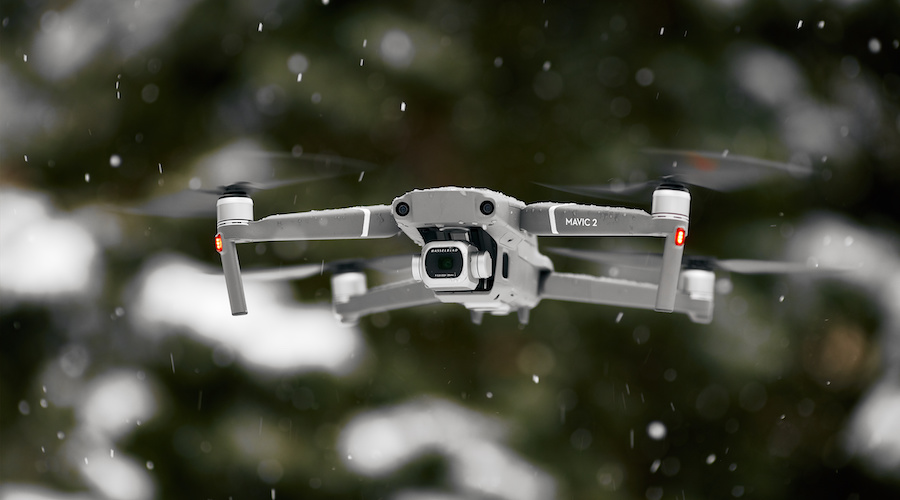One of the biggest changes soon to be implemented for the Part 107 rules finally allows commercial drone pilots to fly at night without a waiver. This is a huge step forward for the industry as a whole and opens up lots of opportunities for drone work without the red tape.
However, the requirement for appropriate anti-collision lights still remains for flying a drone at night. Built-in lights are rarely bright enough to comply with FAA requirements, which means you will need to get a third-party accessory. We have done extensive testing of the different strobe lights in the market to help you decide which one is right for you.
The products
To present a comprehensive list of the current drone light products, we tested seven different products:
All these products are marketed as “drone strobe lights.” Each one is compact and lightweight enough to be appropriate for use with drones – even the ultraportable foldable models. Their prices range from $24.99 to $59.99.
The testing process
To streamline the testing process, we narrowed down the objectives to answering these questions:
- Can the lights comply with the 3-statute mile visibility requirement of the FAA?
- How well do the lights perform when mounted at both the front and top of the drone?
Worth noting at this point is the purpose of installing anti-collision lights on your drone. The reason that the lights are supposed to go at the top of the drone is so that they are visible to any manned aircraft flying overhead. They are not primarily meant to make the drones visible to drone pilots. However, if the lights are bright enough to be visible from the ground, then all the better for them.
Testing was done in the Thumb Butte Recreation Area in Prescott, AZ. The observer team was located in an open parking lot exactly 3 statute miles away. Testing was done on a clear night with good visibility.
Comparison of features
| Parameter | LumeCube Strobe | FireHouse Arc 2 | TopSun Cree | TopSun “Dome” | Ulanzi DR-01 | Ulanzi DR-02 | FireHouse Arc V |
| No. of LEDs | 4 | 4 | 5 | 5 | 5 | 2 | 5 |
| Protection | Plastic, not waterproof | Plastic film on top | Exposed | Plastic, not waterproof | Fully enclosed plastic container | Fully enclosed plastic container | Fully enclosed plastic container |
| Modes | SteadyStrobeFlash | SteadyStrobeFlash | Strobe only | Strobe only | SteadyStrobeFlash | StrobeFlash | SteadyStrobeFlash
Mixed |
| Multicolor | Yes (with red and green covers) | No (available in other colors) | No | No | WhiteGreenRed | WhiteGreenRed | No |
| Charging | MicroUSB | MicroUSB | MicroUSB | MicroUSB | USB C | USB C | MicroUSB |
| Weight | 11 g | 7 g | 5 g | 17 g | 15 g | 6 g | 12 g |
| Runtime | 6 hours | No data | 3 hours | 3 hours | 20 hrs (flashing)2 hrs (steady) | 8 hours | 4.5 hours |
| Made in | China | USA | China | China | China | China | USA |
| Price | $39.95 | $59.99 | $29.88 | $29.79 | $28.96 | $24.95 | $34.00 |
Before proceeding to the results of the test, let us look at the individual features for each product we have reviewed. All the products have either 4 or 5 5 LEDs, except for the Ulanzi DR-02 which only has two. All of them weigh 17 grams or below, making each of them light enough to be used in drones with no flight performance issues expected.
In terms of protection from the elements, we would go with any of the three with fully enclosed plastic containers: the two products from Ulanzi, and the FireHouse Arc V. The Topsun Cree leaves a lot to be desired in this category, as it is the only one with fully exposed electronics and no protection whatsoever.
Most of the products come with at least three lighting modes – steady, strobing, and flashing. Both strobe and flash modes can be helpful in maintaining visibility while conserving battery power. The TopSun products exclusively work in Strobe mode, but we don’t consider this a huge disadvantage.
Both Ulanzi products can shift colors with a press of a button. The LumeCube Strobe also has a similar feature, although it is only done by switching between different colored plastic panels. The FireHouse Arc 2 has no feature for changing colors, but the product itself is available in different colored LEDs. All other products emit only white light.
When it comes to total operation time on a single battery cycle, the products range from 3 hours to 20 hours. Unfortunately, the FireHouse Arc 2 does not include this parameter under its specifications. We don’t see any major issues related to total runtime, especially if you make it a point to recharge the lights before each start of a planned mission. Products from the Ulanzi brand have a USB-C port for charging, while all others use a more old-fashioned microUSB port.
With the sole exception of the US-based FireHouse products, all products we reviewed were made in China.
Comparison of visibility
The lights were mounted in two different ways using Velcro strips on a DJI Mavic Zoom during this trial:
- At the front of the drone
- At the top of the drone
The goal of the first test was to determine if the lights were visible from 3 statute miles when they were facing directly towards the observer. This would be enough to establish compliance with FAA requirements.
However, the second test is how anti-collision lights are meant to be installed. Since they will not be facing the observer directly, we expect visibility to diminish in the second test compared to the first.
| Parameter | LumeCube Strobe | FireHouse Arc 2 | TopSun Cree | TopSun “Dome” | Ulanzi DR-01 | Ulanzi DR-02 | FireHouse Arc V |
| Visible from 3 SM? (Front-facing) | Yes | Yes | Yes | Yes | Yes | Yes | Yes |
| Visible from 3 SM? (At the top) | Yes, at an angle | Yes, at an angle | No | No | No | No | Yes |
Based on the results of the first test, each one of the strobe lights was somewhat visible from 3 statute miles away. This means that they comply with the FAA’s minimum requirements for night flight. Between the different lights, the LumeCube Strobe and both FireHouse products proved to be exceptionally bright and easy to spot in the night sky.
The second test was a lot more challenging. Mounting the lights at the top of the drone rendered most of them barely visible to completely invisible. In the case of the LumeCube Strobe and the FireHouse Arc 2, the lights became visible at certain points while the drone was making a 360-degree yaw.
Only the FireHouse Arc V remained clearly visible during the second test. Aside from its very bright LEDs, the beveled plastic cap of the Arc V was probably what helped its light disperse in all directions. For such a simple feature, this single design decision has helped the Arc V stand out from all the other products in this trial.
It’s worth mentioning that the lights from TopSun and Ulanzi were visible using binoculars. While this is not valid for maintaining visual line of sight, it’s an indicator that they might still remain visible at distances closer than 3 statute miles.
In every trial, switching the colors from white to either green or red diminished the visibility of the lights. If you’re planning to push the drone to the 3-SM limit, we suggest sticking with white light.
Which one is the best?
The choice is quite clear – the FireHouse Arc V is the only product we have tested that remained visible even when mounted at the top of the drone. Not only does the plastic covering protect the light from the elements but also serves to disperse the light along a 360-degree plane.
If we had to identify runner-up winners, it would be a toss-up between the LumeCube Strobe and the FireHouse Arc 2. These two proved to be easier to spot than any of the lights from the TopSun and Ulanzi brands.
Between Ulanzi and TopSun, we would give a slight edge to the Ulanzi lights because of their multicolor function. For bigger drones, you have the option of placing a red light on one side and a green light on the other. This is useful for determining the attitude of the drone even when it’s completely dark.
The overall ranking is as follows:
- FireHouse Arc V
- LumeCube Strobe
- FireHouse Arc 2
- Ulanzi DR-01 and Ulanzi DR-02
- TopSun Cree and TopSun “Dome”
Technically, all the lights we have tested in this trial can be used to comply with the FAA requirements for flying a drone at night. This is solely based on the results of the first round of tests. However, anti-collision lights are not meant to be installed at the front of the drone – they should be at the top.
The easy solution to this dilemma is to install two anti-collision lights on your drone – one at the front and one at the top. This makes them visible both to you and to any aircraft passing above. Fortunately, these anti-collision lights are light and inexpensive enough that using two of them at the same time should not be a huge setback.
Note: Pilot Institute is part of the Amazon Associates program. We may earn a commission on sales, although this does not increase the cost for you.



